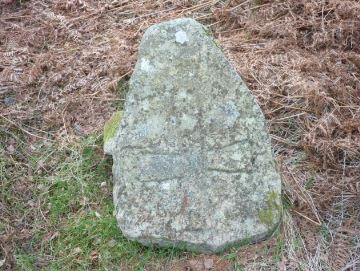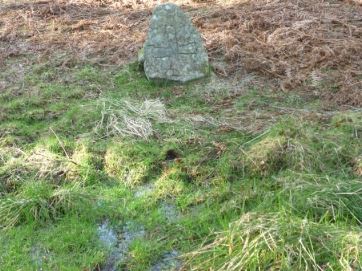Article 3 - St Kentigern's (Mungo)
and the Mystery of St Machar
Article 3 - St Kentigern's (Mungo)
and the Mystery of St Machar
Date of death (Mungo) – 603 or 612
Glengairn Church Ruin – Grid Ref NO 353969
“St Machar’s” cross and well – Grid Ref NO 503998
Many of us know that St Kentigern had the pet name Mungo, and that St Mungo is the patron saint of Glasgow. All of us know that the Scottish Episcopal Church in Ballater is dedicated to St Kentigern, but we don’t all know how this came about because Ballater is a long way from Glasgow. What is equally intriguing is how St Machar’s name is involved in all this and how the incised stone cross in Balnagowan wood, one mile from Aboyne, came to be called St Machars Cross. To cast light on this is not easy, but to start, I must tell you the traditional story of St Mungo.
Glengairn shares with the City of Glasgow the patronage of St Kentigern (Mungo) but while the connection with Glasgow is strong, the connection with Glengairn is no more than a dedication. This can be explained best by reference to what we know or think we know about the life of the Saint.
The date of his death is variously recorded as 603 and 612, and there is general agreement that the main events in his life occurred in the latter part of the 6th century. Mungo’s mother (I will call him here by his pet name) was Thenaw who was the daughter of the Brythonic king Lleuddun who ruled the Haddington region in the modern county named after him, West Lothian. Thenaw fell pregnant after being seduced and her furious pagan father had her thrown from the heights of Traprain Law. Surviving, she was abandoned in a coracle in which she drifted across the Forth to Culross in Fife. There Mungo was born. Six hundred or so years later two medieval biographies were written of Kentigern, the first at the request of Herbert, Bishop of Glasgow (1147 – 1164) and the second by Jocelyn a monk of Furness and authorised by Jocelyn Bishop of Glasgow (1175 – 99). Mention is also made of him in the Sprouston Breviary and the Aberdeen Breviary. Much is written in these sources and about these sources but his life can be briefly summed up by narrating that in Culross he was adopted by St Serf, and was declared to be his successor. Due to the envy of his fellow students he left Culross, connected with St Ninian, but sought refuge in Wales where he met St David. In time Rederech who had become king of Cumbria asked Mungo to return to Strathclyde where a community grew up round him becoming known as Clas-gu (meaning “dear family”). Here he founded a church where Glasgow Cathedral now stands and became Bishop of Glasgow. He is said to have met St Columba and died in either 603 or 612. It was a full life but we look in vain for any mention of his time in Glengairn.

So what was his connection with Glengairn? Many dedications of churches were made to St Kentigern all over Scotland and by the 15th century St Mungo had become one of the major Saints of Scotland. In 1449 Glasgow Cathedral was described as “the most stately among cathedrals in Scotland in which the bodies of many saints especially St Kentigern repose”. It would not have been unusual for the country church at Glengairn to have been dedicated at an early date to this most important Scottish saint. There certainly was a church of that name. Its ruins stand near the point where the river Gairn joins the river Dee about a mile west of the old Ballater railway station, and can be reached either by driving to the road bridge which crosses the Gairn where just before the bridge a steep road goes down to the left and the car can be parked beside the church near some farm buildings: or, more interestingly, by walking from the old Ballater railway station westwards along the track formed to take the railway to Braemar. Immediately before the track would have crossed the Gairn you will see the ruin of the pre-Reformation c hurch of St Kentigern on your left. Part of the east gable and most of the south wall remain, but the rest is in ruins, and as is usual in many pre- Reformation churches, the graveyard has moved into the nave. There must have been a settlement near the church, but signs of it are not visible. During the seventeenth and eighteenth centuries the Catholic population withdrew up Glengairn and there is the remains of a church up there which is sometimes mistaken for the original St Kentigern’s but is in fact a church used by the Catholics of Glengairn during the post Reformation period right up to the late eighteenth century.
There is evidence of a cult of St Mungo surviving up to the early nineteenth century. In 1892 a Mrs McKenzie in Laggan in Glengairn gave an account of her youth which includes the following paragraph:- “People were afraid not to go and celebrate the feast o’ St Mungo at Foot o’ Gairn because if they didn’t go, there was a saying that they wadna live till next year. There is a well at Foot o’ Gairn called St Mungo’s. The fair held on the hillside near Abergairn was known as Fel McCha The district was dedicated to St Mungo. Every church had a saint’s name and a holiday”.
“Fel” is Gaelic for “fair”, but who or what is McCha? There is a school of thought which maintains that McCha or Mo Cha as it is sometimes written is Machar. Professor Colm O’Boyle of Aberdeen University suggests albeit tentatively that the Brythonic name Cunotigerno may have metamorphosed into MoCho or MoCha or MoChu by the common practice of the day namely that first the possessive Mo or Ma (my) was added at the front, and then all but the first syllable of Cunotigerno is dropped (as in Al for Alexander) to give MoChu. And with nasalisation that became Mungo. And then O’Boyle argues that in Gaelic the second vowel –u would normally be very unclear so –a is a possible variant giving Mocha or Macha which with the stress on the second syllable is not all that far from Machar! Furthermore, in some local histories of Glengairn Mungo was called Mocha.
So, what are we to make of this? If we accept the arguments, we must conclude that Mungo and Machar are variants of the same name the one through the Brythnic language route, and the other through the Gaelic language. And furthermore, the evidence for the very existence of St Machar has come under scrutiny. The traditional story of his being sent to the Picts by St Columba with instructions to build a church where a river formed the shape of a crozier does not appear until the date of the Aberdeen Breviary in the late 15th century. There is no mention of St Machar in any of the biographies of St Columba There is no evidence that either St Mungo or St Machar ever went to Glengairn, but both were honoured there, Mungo in the name of the annual fair and in the name of the church (Kentigern) and Machar’s name was used in the Confiteor (prayer of public confession) in Glengairn. If we don’t accept the arguments, then two separate saints have been honoured there.


Before trying to sum up this conundrum, I must mention the carved stone known locally as St Machar’s Cross at Balnagowan Wood near Aboyne. Formerly known as St Muchreiha’s Cross or Stone, the name St Machar’s Cross was ascribed to it in 1918 by A B Scott since when it has been known by that name and it is shown as such on the Ordnance Survey Map. O’Boyle however sees no evidence to link the two names, but I must treat the stone as an important piece of evidence from the age of the saints having a possible connection with St Machar (or St Muchreiha or St MoCha or St Mungo?). It is a cross-incised stone standing about 3’ high, about 2’ broad and conical in shape. The cross on the east face of the stone has equal and expanding arms. A large stone with an artificial hollow once stood near the cross and was known as the saint’s chair. The well was an excellent spring which was formerly encased in masonry which had been removed by 1865. The saint’s chair was broken up and removed for building purposes.
in about 1810. My photo shows the accumulated water from the well which is about 7 m. to the right of the stone in the lower photo. No one has tried to date this stone except that there is general agreement that it is from the age of the saints. If I am right in suggesting that neither saint ever went to Glengairn / Aboyne then this leaves open the possibility that the St Machar Cross is associated with one of the Cromar saints that I will be dealing with later. I must say that it looks unlikely that either St Machar or St Mungo had any connection with this cross and it is also unlikely that St Machar had any physical connection with Glengairn, and it is more likely that his name became associated with the church and district through the linguistic mis-understandings referred to above.
© Hugh Cochran 2012
Discover more….
